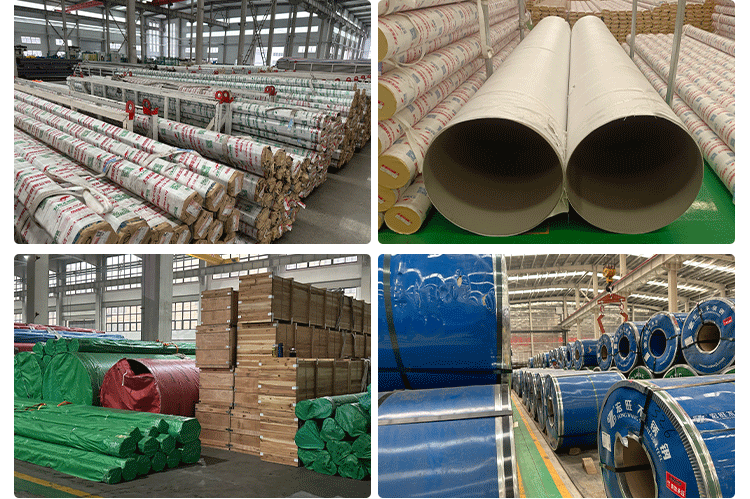Analysis and Comparison of Stainless Steel 304, 304L, and 316
time2024/09/24

- Stainless steel is a material widely used across various industries, renowned for its corrosion resistance and versatility. Among the numerous grades of stainless steel, 304, 304H, 304L, and 316 are the most common, as specified in the ASTM A240/A240M standard for “Chromium and Chromium-Nickel Stainless Steel Plate, Sheet, and Strip for Pressure Vessels and General Applications.”
Overview of Stainless Steel
Stainless Steel: A type of steel known for its corrosion resistance and non-rusting properties, containing at least 10.5% chromium and a maximum of 1.2% carbon.
Stainless steel is a material widely used across various industries, renowned for its corrosion resistance and versatility. Among the numerous grades of stainless steel, 304, 304H, 304L, and 316 are the most common, as specified in the ASTM A240/A240M standard for “Chromium and Chromium-Nickel Stainless Steel Plate, Sheet, and Strip for Pressure Vessels and General Applications.”
These four grades belong to the same category of steel. They can be classified as austenitic stainless steels based on their structure and as 300 series chromium-nickel stainless steels based on their composition. The primary differences among them lie in their chemical composition, corrosion resistance, heat resistance, and application fields.
Austenitic Stainless Steel: Primarily composed of a face-centered cubic crystal structure (γ phase), non-magnetic, and mainly strengthened through cold working (which may induce some magnetism). (GB/T 20878)
Chemical Composition and Performance Comparison (Based on ASTM Standards)
304 Stainless Steel:
Main Composition: Contains approximately 17.5-19.5% chromium and 8-10.5% nickel, with a small amount of carbon (below 0.07%).
Mechanical Properties: Exhibits good tensile strength (515 MPa) and elongation (around 40% or more).
304L Stainless Steel:
Main Composition: Similar to 304 but with a reduced carbon content (below 0.03%).
Mechanical Properties: Due to the lower carbon content, the tensile strength is slightly lower than 304 (485 MPa), with the same elongation. The lower carbon content enhances its welding performance.
304H Stainless Steel:
Main Composition: Carbon content typically ranges from 0.04% to 0.1%, with reduced manganese (down to 0.8%) and increased silicon (up to 1.0-2.0%). Chromium and nickel content are similar to 304.
Mechanical Properties: Tensile strength (515 MPa) and elongation are the same as 304. It has good strength and toughness at high temperatures, making it suitable for high-temperature environments.
316 Stainless Steel:
Main Composition: Contains 16-18% chromium, 10-14% nickel, and 2-3% molybdenum, with a carbon content below 0.08%.
Mechanical Properties: Tensile strength (515 MPa) and elongation (greater than 40%). It has superior corrosion resistance.
From the above comparison, it is evident that the four grades have very similar mechanical properties. The differences lie in their composition, which leads to variations in corrosion resistance and heat resistance.
Corrosion Resistance and Heat Resistance Comparison
Corrosion Resistance:
316 Stainless Steel: Due to the presence of molybdenum, it has better corrosion resistance than the 304 series, especially against chloride corrosion.
304L Stainless Steel: With its low carbon content, it also has good corrosion resistance, suitable for corrosive environments. Its corrosion resistance is slightly inferior to 316 but is more cost-effective.
Heat Resistance:
316 Stainless Steel: Its high chromium-nickel-molybdenum composition provides better heat resistance than 304 stainless steel, especially with the molybdenum enhancing its oxidation resistance.
304H Stainless Steel: Due to its high carbon, low manganese, and high silicon composition, it also exhibits good heat resistance at high temperatures.
Different Stainless Steel Application Fields
304 Stainless Steel: A cost-effective and versatile base grade, widely used in construction, manufacturing, and food processing.
304L Stainless Steel: The low-carbon version of 304, suitable for chemical and marine engineering, with similar processing methods to 304 but better suited for environments requiring higher corrosion resistance and cost sensitivity.
304H Stainless Steel: Used in superheaters and reheaters of large boilers, steam pipes, heat exchangers in the petrochemical industry, and other applications requiring good corrosion resistance and high-temperature performance.
316 Stainless Steel: Commonly used in pulp and paper mills, heavy industry, chemical processing and storage equipment, refinery equipment, medical and pharmaceutical equipment, offshore oil and gas, marine environments, and high-end cookware.3
High Quality 304 Stainless Steel Pipe Corrosion Resistant Suitable for Various Industrial Applications
304L stainless steel heat exchanger tubes, thin-walled stainless tube, stainless pipe for food, stainless steel fluid tubes.
Stainless pipes are used to transport various fluids such as water, chemicals, gases, and other liquids in industrial settings
316 stainless steel pipes offer excellent corrosion resistance and high strength for marine and industrial applications.




